San Jose Mercury News reporter Marisa Kendall chronicles the next step in the redevelopment of the dilapidated Vallco Mall in Cupertino.
The City of Cupertino has given developer Sand Hill Properties approval to proceed with its application to fast track the building of 2,402 new homes, half of which would be designated as affordable, under Senate Bill (SB) 35.
See the original story at the San Jose Mercury News.
Vallco project clears first hurdle under controversial new state law
By Marisa Kendall
CUPERTINO—A plan to transform the defunct Vallco Mall into a massive housing complex, complete with shopping and a roof-top garden, is one step closer to breaking ground after clearing its first hurdle under California’s controversial new development law.
The project, which would include 2,402 housing units, 1.8 million square feet of office space and 400,000 square feet of retail, is eligible for the fast-track under SB 35, Cupertino officials said Monday. It’s a major milestone for the project, which has been bogged down in delays for years. But experts say it’s also big news for the Bay Area and the state, which has been watching the Vallco project as a test case of a law that sought to speed up residential development and help ease the region’s dire housing crunch.
“This is an important first step toward a viable future at Vallco,” Reed Moulds, managing director of Vallco owner Sand Hill Property Company, wrote in a news release.
Sand Hill proposed the project in March under SB 35, which requires California cities to approve certain residential and mixed-use projects. City officials had 90 days to review the application and reject it if they found major defects that would make the project ineligible — such as running afoul of the city’s big-picture zoning and planning rules, or failing to include enough affordable housing. Officials found no such problems, and gave the project its first thumbs-up in a letter sent to Sand Hill on Friday. They announced the decision Monday.
Both SB 35 and plans to redevelop Vallco have sparked controversy in Cupertino and beyond. Critics of the law worried it stripped city officials of the right to dictate how their towns are developed. And a prior proposal to redevelop Vallco was shot down by voters in 2016.
Ignatius Ding, a 41-year Cupertino resident, feared the Vallco project would make already grueling commutes worse.
“They are going to triple the traffic load,” he said. “Gridlock is ahead in 12 to 24 months.”
Ding also accused Sand Hill of using inaccurate calculations in its project proposal, and failing to do enough to protect the environment. Ding said he and Friends of Better Cupertino have filed a petition asking city officials to reverse their decision green-lighting the Vallco plan.
Sen. Scott Wiener, SB 35’s author, said he’s “thrilled” the Vallco project passed its first test under his bill.
“This is exactly the kind of project that should be moving forward under SB 35 — a project that will deliver significant housing for different income levels, a project that’s been stalled for a long time in a city that’s not producing very much housing,” said Wiener, D-San Francisco. “So this is a good and important step.”
The Vallco project is one of the first in the state to proceed under SB 35. In May, San Francisco confirmed an affordable housing development at 681 Florida St. in the Mission District is eligible for fast-track review under SB 35, according to the developer, Mission Economic Development Agency, or MEDA. Earlier this month, Berkeley denied an SB 35 application for a mixed-use development at 1900 Fourth St.
The Vallco developers still have a ways to go. Cupertino officials have until Sept. 24 to give the project their final approval — after scrutinizing small details like where public art would go, and how trash collection would be managed. If it passes that final hurdle, Sand Hill can start construction.
Meanwhile, the city has continued working on a separate plan for the Vallco site, irrespective of the SB 35 proposal. Two alternative proposals, written with community input, would include as much housing as the Sand Hill plan, but add more retail space. Sand Hill representatives have said they would be willing to review the city’s plan, and even build it instead, if they can do so in a timely manner.
The community-driven plans might end up being more attractive for residents than Sand Hill’s, because they could be negotiated to include extra benefits like provisions for a new city hall or performing arts center, and money for local schools, said Jean Bedord, who publishes the Cupertino Matters newsletter and teaches in San Jose State University’s School of Information. But her biggest concern is seeing something finally take the place of Cupertino’s mostly vacant mall.
“Let’s put it this way — I want one or the other implemented,” Bedord said. “I’m on board with moving ahead with development.”
Pilar Lorenzana, deputy director of affordable housing advocacy organization SV@Home, worries whatever alternative plan the city proposes could be bogged down by lawsuits and ballot initiatives — delays SB 35 projects don’t face.
Lorenzana hopes that Monday’s news will embolden other developers to submit SB 35 applications, by clearing up some of the mystery that had surrounded the new law.
“I think a lot of the developers are waiting to see what sort of hurdles come up when someone submits an SB 35 project,” she said.
Wiener agrees Vallco’s preliminary approval will have a far-reaching impact.
“Vallco sends a very powerful signal,” he said, “that when we say we need more housing, we mean it.”
